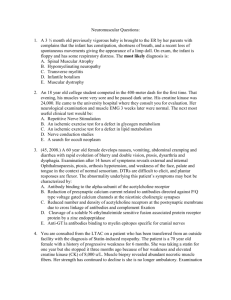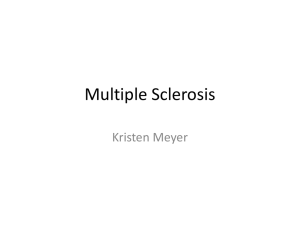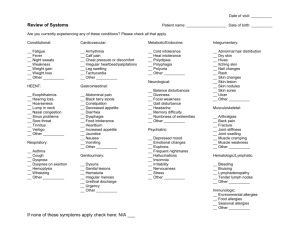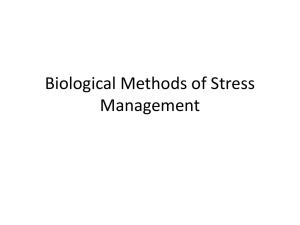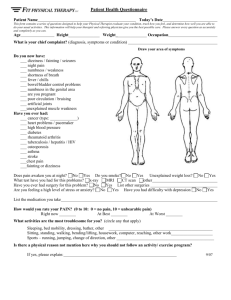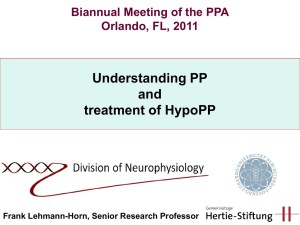Supplementary Material (doc 32K)
advertisement
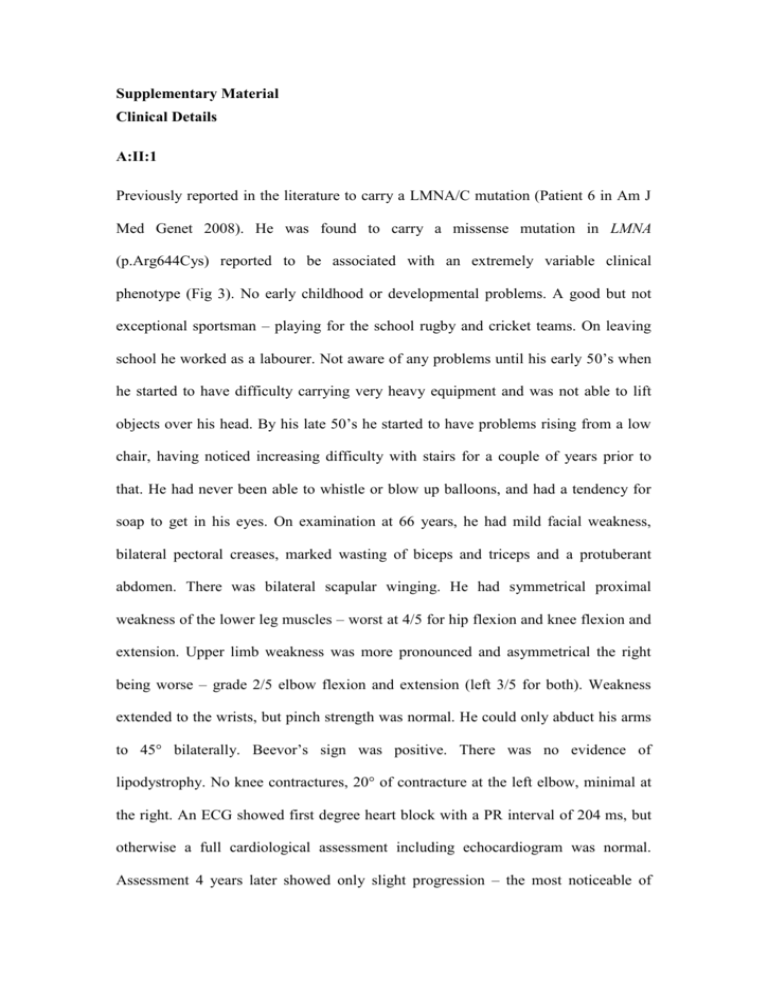
Supplementary Material Clinical Details A:II:1 Previously reported in the literature to carry a LMNA/C mutation (Patient 6 in Am J Med Genet 2008). He was found to carry a missense mutation in LMNA (p.Arg644Cys) reported to be associated with an extremely variable clinical phenotype (Fig 3). No early childhood or developmental problems. A good but not exceptional sportsman – playing for the school rugby and cricket teams. On leaving school he worked as a labourer. Not aware of any problems until his early 50’s when he started to have difficulty carrying very heavy equipment and was not able to lift objects over his head. By his late 50’s he started to have problems rising from a low chair, having noticed increasing difficulty with stairs for a couple of years prior to that. He had never been able to whistle or blow up balloons, and had a tendency for soap to get in his eyes. On examination at 66 years, he had mild facial weakness, bilateral pectoral creases, marked wasting of biceps and triceps and a protuberant abdomen. There was bilateral scapular winging. He had symmetrical proximal weakness of the lower leg muscles – worst at 4/5 for hip flexion and knee flexion and extension. Upper limb weakness was more pronounced and asymmetrical the right being worse – grade 2/5 elbow flexion and extension (left 3/5 for both). Weakness extended to the wrists, but pinch strength was normal. He could only abduct his arms to 45° bilaterally. Beevor’s sign was positive. There was no evidence of lipodystrophy. No knee contractures, 20° of contracture at the left elbow, minimal at the right. An ECG showed first degree heart block with a PR interval of 204 ms, but otherwise a full cardiological assessment including echocardiogram was normal. Assessment 4 years later showed only slight progression – the most noticeable of which was a right footdrop. Hand-grip dynamometry gave maximum values of 11.6 KgF on the right and 19.6 KgF on the left. A:II:2 Individual A:II:2 was assessed at 64 years in order to establish the clinical significance of a LMNA missense mutation that had been identified in II.1. Childhood milestones had been normal and she had been a fast runner, the fastest amongst her peers. She recalled starting to have falls due to her knees giving way from about 16 years of age. She experienced aching in her legs and increasing difficulty managing stairs. Clinical examination in her 3rd pregnancy at 24 years of age showed marked “enfeeblement” of the right biceps and of the distal quadriceps bilaterally. Mild pes cavus was noted. She was diagnosed with Erb’s juvenile dystrophy (scapulohumeral muscular dystrophy). There was very little progression of her condition. By 27 years she continued to have difficulty walking, climbing stairs, holding her children or brushing her hair. Examination revealed asymmetric proximal wasting and weakness of the thighs (R > L) and of the right arm and forearm, and CPK 87 IU/L. The diagnosis was reconsidered because of “bottleshaped” wasting of the distal thighs with pes cavus and the diagnosis changed to peroneal muscular atrophy. Further clinical review at 29 years reported asymmetric onset of weakness in both arms, 18 months before the development of asymmetric weakness in both legs, left greater than the right. EMG and muscle biopsy at 29 years were each compatible with a myopathy and the diagnosis reverted to that of limb-girdle muscular dystrophy. At 56 years she was admitted with a non-ST elevation myocardial infarct with a raised troponin-T of 0.12 U/L. ECG showed “very marked first degree heart block”. The troponin-T continued to be slightly elevated at 0.11 U/L. Coronary angiography showed “surprisingly” normal coronary arteries. But she went into atrial flutter and subsequently required DC cardioversion and a permanent pacemaker inserted. There was no evidence of cardiomyopathy. She became a lot weaker from the late 50’s, first starting to use a wheelchair out-ofdoors from 60 years. She had never been able to blow up balloons, but could whistle. She did not sleep with her eyes open. At 63 years she had a CVA with nominal aphasia. Examination at 64 years was complicated by a recovering right-hemiplegia. She had a flat mid-face with paucity of movement bilaterally. Her lips were large and full with an asymmetric smile, the righter weaker, and a fair left pucker. The left upper limb distal strength especially the hand and wrist were normal, with weakness of elbow flexion and extension. There was winging of the scapula; abduction of the shoulder to 45o. In the lower limb there was proximal weakness of the left hip (4-), knee flexion and extension (2 and 3), ankle dorsiflexion and plantarflexion (3 and 4). There were contractures at the elbows - right 30o, left 20o; and right knee 20o. There was no pes cavus. The diagnosis of autosomal dominant Emery-Dreifuss muscular dystrophy was considered because of her own and her brother’s contractures together with her history of cardiac dysrhythmia and pacemaker insertion. She does not carry the LMNA variant. Clinically her phenotype is that of later onset FSHD, originally diagnosed in 1970 as Erb’s juvenile muscular dystrophy (scapulohumeral muscular dystrophy). A:III:1 No early childhood problems, a member of the school cross-country and netball teams. She had no problems with ladders, stairs or low chairs. Could whistle, blow up balloons and did not sleep with her eyes open. On examination at 42 years she could bury her eye-lashes deeply and could whistle. She could achieve full elevation of both arms, had no difficulty rising from a low chair with her arms folded and could walk on tip-toe and her heels with ease. Hand-grip dynamometry gave maximum values of 22.8 and 19.6 kgF respectively for the right and left hands. She was adjudged to be clinically unaffected or presymptomatic. A:III:2 Early childhood and development normal. Not the fastest at running, no difficulty climbing ropes or doing push-ups. First became aware of difficulty holding a hawk on his abducted arm at 34 years. With hindsight he felt he had always had poorly developed upper arms, and his girl-friend had previously noted his “chicken-wings” in his mid-20s. There were no functional problems with his legs – managing stairs, ladders, low chairs with no difficulty. He had never been able to whistle but could suck and did not sleep with his eyes open. On examination at 37 years he had subtle weakness of eye closure, the lower limbus of the sclera being visible, but otherwise could bury his eye-lashes. He had an asymmetric smile with flat horizontal lips but normal cheek puff. There was marked asymmetric wasting of the upper arms especially of the left biceps and triceps with relative sparing of the deltoid and asymmetric bilateral pectoral creases (right worse than left). He could abduct his arms to 60° and 55°, achieving full elevation on manual fixation of the scapula. Biceps and triceps were very weak on the left (2 and 3 on MRC grades) compared to 4- for both on the right. Distal strength in the wrists and hands was normal as were all assessments in the lower limb apart from mild weakness of knee extension. He had a positive Beevor’s sign. He could rise from a chair with his arms folded and walk on tip-toe and his heels with ease. Re-examination at 41 years was essentially unchanged except that the weakness of biceps had progressed to grade 1/5. Shoulder abduction was unchanged. Hand-grip dynamometry gave maximum values of 31.3 and 27.4 kgF for the right and left hands respectively. There were no contractures. ECG and echocardiography were unremarkable. Family B B:II:1 and B:II:2 Neither sister reports any clinical problem. Examination at 61 and 56 years respectively was completely normal B:II:3 (proband) Originally referred at 41 years because of a history suggestive of connective tissue problems with a “Marfanoid” appearance, the features included recurrent knee dislocations (from age 7), short stature, joint hypermobility myopathic facies and a high arched palate (Fig 4). There was no family history of ocular or cardiac anomalies seen in Marfan Syndrome. Marfan syndrome was excluded clinically, including normal ophthalmic and cardiac assessments. Examination at 42 years: weakness of eye closure with difficulty burying the eyelashes was noted. There was no weakness of proximal or distal muscles in the upper limb. There was mild weakness of hip flexion and ankle eversion, with bilateral pes cavus and clawing of the toes. NCV were normal, EMG demonstrated no abnormality, facial EMG was not tolerated. A muscle biopsy (left quadriceps) showed no evidence of inflammation, dennervation or of muscular dystrophy. Over the years she has slowly deteriorated with predominantly distal upper-limb weakness and proximal lower-limb weakness. However she remains ambulant for short distances. Cranial and spine MRI have been normal. The clinical phenotype is unusual and no diagnosis has been made. DM2, HMSN1A and FSHD have all been tested although none of these was ever considered a strong candidate, but testing undertaken to exclude them as a potential confounder. B:II:4 The younger sister of II:3 has not been examined but is reported by the family to have similar problems with her feet and a very similar facial appearance to her sister with paucity of movement of the mid face and upper lip with weakness of eye closure. Photographs shown to (MTR) support this assertion.
